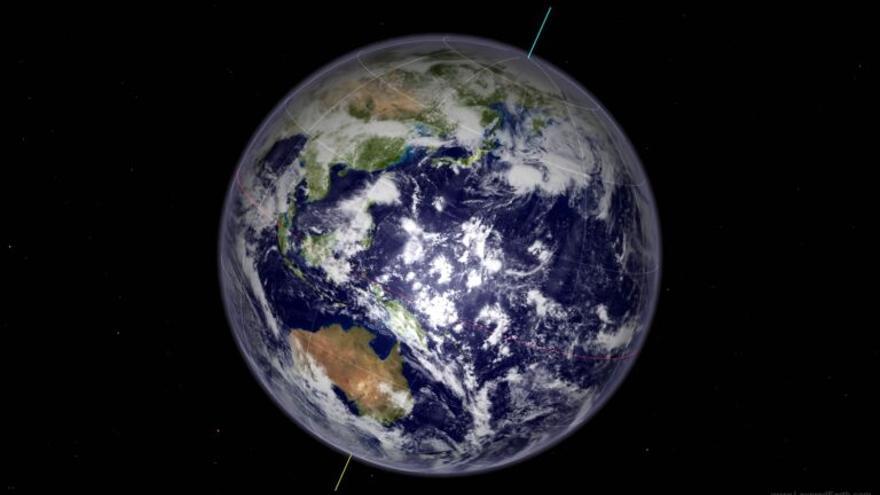Climate change not only alters the global temperature, but it is also capable of causing transformations on the planet that were unimaginable until now. The very axis around which the Earth rotates is moving. The melting of glaciers and other frozen masses due to global warming is the cause from a pole shift that occurred in the 1990s, scientists have now detected.
Contrary to what one might assume, the locations of the North and South Poles are not static, unchanging places on our planet. The axis around which the Earth rotates, or more specifically the surface from which that invisible line emerges, is always moving due to processes that scientists are still studying. In any case, the way water is distributed on the Earth’s surface is a factor that drives such drift.
Glacier melt has already redistributed enough water to cause the direction of polar drift to shift and accelerate eastward in the mid-1990s, according to a new study published in Geophysical Research Letters.
“The rapid melting of ice due to global warming was the most likely cause of the directional change of polar drift in the 1990s,” says Shanshan Deng, a researcher at the Institute of Geographic Sciences and Natural Resources Research of the Chinese Academy of Sciences and an author of the new study.
The Earth spins around an axis like a top, explains Vincent Humphrey, a climate scientist at the University of Zurich who was not involved in this research. If the weight of a top is varied, the top would begin to tilt and wobble as its axis of rotation changes. The same thing happens to the Earth when weight shifts from one area to another.
Researchers have been able to determine the causes of polar drift starting in 2002 based on data from the Gravity Recovery and Climate Experiment (GRACE), a joint mission of NASA and the German Aerospace Center, launched with twin satellites that year and a mission monitoring in 2018.
The mission collected information about how the planet’s mass is distributed by measuring uneven changes in gravity at different points.
Causes: melting and pumping of water for agricultural uses
Research has determined that the most recent movements of the North Pole towards Russia are caused by factors such as molten iron in the Earth’s outer core. Other changes were caused in part by what is called terrestrial water storage change, the process by which all the water on Earth, including frozen water in glaciers and groundwater stored beneath our continents, is being lost through melting and groundwater pumping.
The authors of the new study believed that this loss of water on Earth contributed to changes in polar drift over the past two decades by changing the way the world’s mass is distributed. In particular, they wanted to see if it could also explain the changes that occurred in the mid-1990s.
In 1995, the polar drift direction changed from south to east. The average drift speed from 1995 to 2020 also increased about 17 times with respect to the average speed recorded from 1981 to 1995.
Now researchers have found a way to turn pole tracking back in time to learn why this drift occurred. The new research calculates the total loss of terrestrial water in the 1990s before the GRACE mission began.
“The findings offer a clue to study climate-driven polar motion in the past,” said Suxia Liu, a hydrologist at the Institute of Geographic Sciences at the University of the Chinese Academy of Sciences and the corresponding author of the new study. “The goal of this project, funded by the Chinese Ministry of Science and Technology, is to explore the relationship between water and polar motion.”
polar drift to the east
Using data on glacial loss and estimates of groundwater pumping, Liu and his colleagues calculated how the water stored on earth changed. They found that contributions from water loss from the polar regions is the main driver of polar drift, with contributions from water loss from non-polar regions. Taken together, all of this water loss explained the eastward shift in polar drift.
“I think it brings some interesting evidence to this question,” Humphrey said. “It tells you how strong this mass change is. It is so big that it can change the axis of the Earth.
Humphrey said that the shift in the Earth’s axis is not large enough to affect daily life. It could change the length of the day we experience, but only by milliseconds.
However, accelerating ice melt cannot fully explain this change, said Deng, who speculated that this small gap could be due to activities related to terrestrial water storage in non-polar regions, such as unsustainable pumping of groundwater for the Agriculture.
Humphrey said that this evidence reveals the great impact that human activity can have directly on changes in the mass of water on Earth. Their study revealed large changes in the mass of water in areas such as California, North Texas, the region around Beijing and northern India, for example, that is, areas that have been pumping large amounts of groundwater for use. agricultural.
“The contribution of groundwater is also important,” Humphrey stressed. “There is, therefore, a local water management problem that is detected with this type of analysis.”
Liu said the research has larger implications for our understanding of terrestrial water storage in the early 20th century. The researchers have 176 years of data on polar drift. Using this methodology and these data, it might be possible to use these changes in direction and speed to estimate how much terrestrial water has been lost in recent years.
Reference article: DOI: 10.1029/2020GL092114
It may interest you: The melting of the poles is accelerating
www.informacion.es
Eddie is an Australian news reporter with over 9 years in the industry and has published on Forbes and tech crunch.
